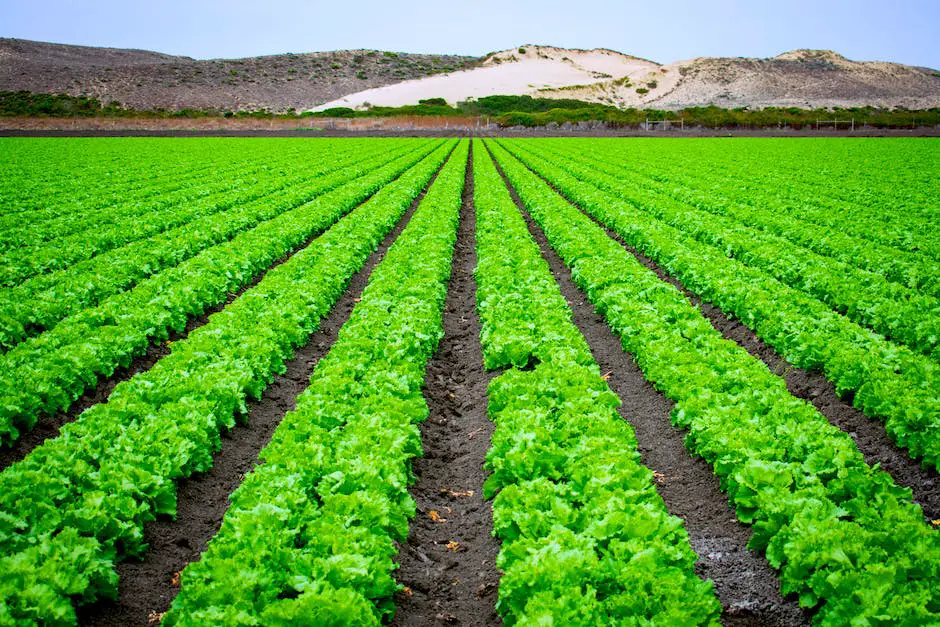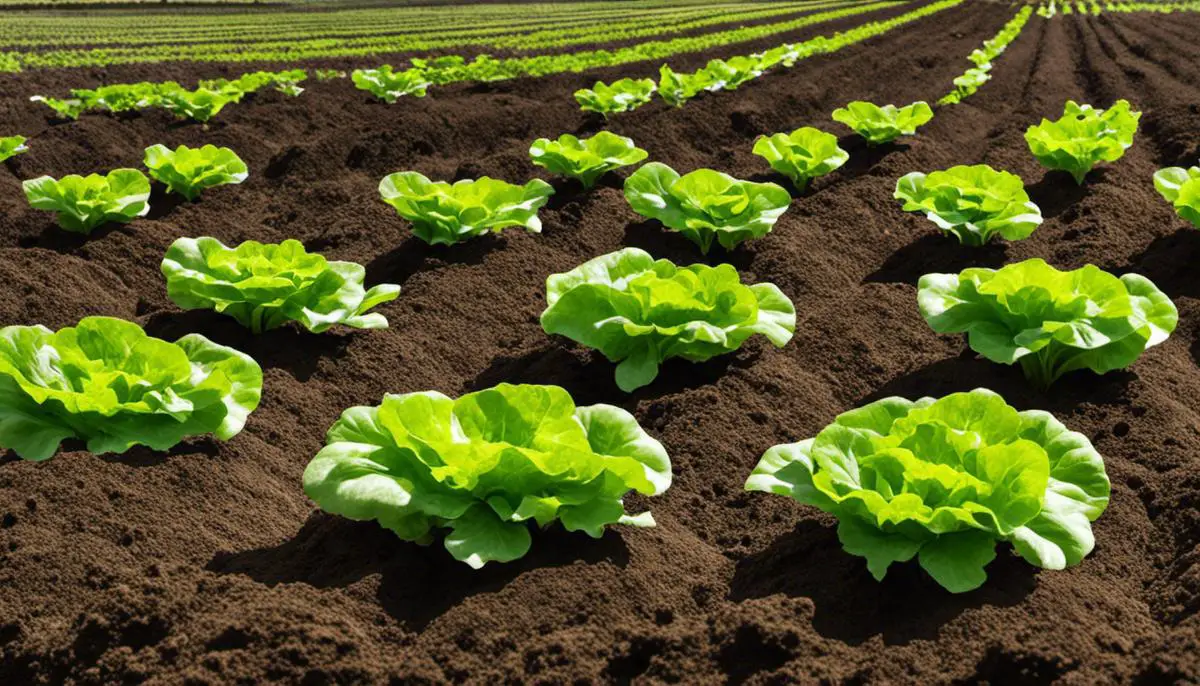Healthy, nutrient-rich soil is the foundation of any successful vegetable garden, and this is especially true when it comes to growing lettuce. The health of these leafy greens largely depends on the quality of the soil in which they are grown. This essay will delve into the specific soil requirements of lettuce, discussing the pH levels, mineral content, and soil texture that make it thrive. We will explore why loamy soil, with its balanced mix of clay, sand, and silt, is particularly conducive to cultivating lettuce. Furthermore, we will shed light on the importance of soil aeration and drainage, and how they contribute to the successful growth of lettuce crops. Lastly, the essay will discuss how integrating organic matter into your soil can improve its fertility, thereby boosting your lettuce plants’ health and productivity.
Understanding Soil Requirements for Lettuce
The Dirt on Lettuce: Finding the Perfect Soil for Great Greens!
Greetings green-thumbed gardeners! In the whirlwind world of backyard gardening and hobby horticulture, the quest for the perfect lettuce crop is a common one. After all, who doesn’t love the satisfying crunch of homegrown greens? Here’s a ‘lettuce’ peel back the soil secrets and get down to the root of the matter – what sort of soil does lettuce grow best in?
Reader Poll: What online courses would interest you?
Growing decent lettuce comes down to understanding what nourishes these leafy green crops. Lettuce, like all veggies, has its particular preferences when it comes to soil, sunlight, and moisture. If the soil is the plant’s bed, then like us humans, lettuce likes a comfortable, nutrient-rich one.
The ideal soil for lettuce is loamy. It’s like the Goldilocks of the soil types. Why? Because loamy soil maintains the perfect balance between sandy and clay soils. Sandy soil can drain too quickly and risks depriving the lettuce of much-needed moisture. On the other hand, clay soil can compact and hinder root development while restricting drainage – a big NO for lettuce that loves well-drained soil.
But wait – there’s more to this loamy lore! Ready for a shocker? Loamy soil contains an amazing mix of sand, silt, and clay. The perfect triad of soil components ensures the right drainage while still keeping the soil moist enough for our leafy friends.
Subscribe to our newsletter!
Lettuce, being a cool-season crop, likes it cool – and loamy soil, being great at retaining water yet providing excellent drainage, fits this bill perfectly. It helps regulate the temperature of the soil, preventing it from overheating on warm days.
From the fertility perspective, lettuce takes the cake – or rather the compost – because it loves nutrient-rich soil! A soil rich in organic matter, particularly compost or well-rotted manure, will work wonders for lettuce growth. Add in a bit of bone meal for phosphorus, and you’re onto a winner!
Don’t forget to balance your soil’s pH. Lettuce likes slightly acidic to neutral soil with a pH range between 6.0 and 7.0. This balance allows your lettuce to absorb all those delicious nutrients from the soil.
In essence, going for the loamy, nutrient-rich, well-draining type with the right pH balance is your best bet for growing lush lettuce. With the right soil in place, you can ‘lettuce’ celebrate the joy of growing incredible greens in your own backyard! Remember, gardening isn’t just about the fruits (or veggies) of your labor; it’s about digging deep and getting your hands dirty. Happy gardening!

Importance of Soil Aeration and Drainage
Continuing down the delicious rabbit hole of lettuce cultivation, it’s time to delve into the pivotal elements of soil aeration and drainage. Any adept gardener worth their salt knows the importance of these two vital factors in ensuring our precious lettuce plants grow healthy, vibrant, and delectable.
To begin, let’s get our heads around the concept of soil aeration. This refers to the process which allows air to circulate freely within the soil. Interconnected spaces within soil particles permit air and water movement essential for root growth. Imagine your lettuce plants like aquatic beings that also require oxygen. Without it, the health and growth of a lettuce plant can suffer significantly. Roots utilize oxygen in processing nutrients, and a low oxygen environment can stall growth and nutrient absorption. It’s like attempting to run a marathon without taking a breath; your lettuce plants need to breathe!
Now let’s talk about soil drainage. Here is where the concept of ‘too much of a good thing’ comes into play. Yes, lettuce plants love their water, but don’t overdo it. Overwatering can cause the roots of your lettuce plants to become oversaturated, leading to dreaded root rot. Proper soil drainage ensures that excess water doesn’t linger long enough to cause this disastrous condition. It’s a delicate balance—your lettuce plants require hydration but overindulging can lead to doom.
How do these two aspects apply directly to your lettuce growing enterprise?
Well, let’s tackle soil aeration first. If you’ve elected to go the container route, ensure your pots have plenty of holes to allow free airflow. Those planting directly in the ground might consider breaking up hard-packed soil before planting your lettuce, promoting good airflow to the roots. Try adding organic material to the soil, such as compost or peat moss. This can serve a duel purpose: enhancing nutrient content and improving aeration while also aiding drainage.
Speaking of drainage, it’s ultimately a game of Goldilocks and the Three Bears. You don’t want soil too soggy or too thirsty, but just right. Overwatering is a common pitfall eager gardeners encounter. Stick to watering your lettuce in the cool morning or evening whenever possible to prevent evaporation. Ensure whether in containers or garden beds, your soil has the ability to drain freely to avoid pooling. Now, you’ve set the stage for your lettuce plants to flourish free from the chains of root rot.
Venture forth armed with this knowledge about soil aeration and proper drainage; your lettuce plants will thank you! And remember, every great gardener knows that the productivity of the land isn’t determined by what you take but what you give back to the soil. Feed it well, give it some breathing room, and let it drain. Your lush, abundant, and happy lettuce crop will surely be proof of your dedicated cultivation.

Integrating Organic Matter into Soil
Boosting Soil Health for Outstanding Lettuce Growth: Integration of Organic Matter
Healthy soil isn’t about just having the right balance of nutrients, it also fully encompasses aspects like soil aeration and drainage, crucial elements for successful lettuce cultivation.
Imagine, a soil bed acting like the lungs of a plant, facilitating a beautiful entanglement known as life. Soil aeration is indeed a life-giving process that dramatically shapes root growth, influencing healthy nutrient absorption. In an adequately aerated soil, there is a dynamic exchange of life-preserving gases – think oxygen and carbon dioxide. Who enjoys a healthy dose of oxygen? Your lettuce plants surely do! In low oxygen environments, plants experience restricted growth and ultimately succumb to suffocation. Make breathing a breeze for your plants – aerate your soil!
In addition to breathing, water can pose a make or break situation for lettuce roots. Here’s where soil drainage waltzes into the spotlight. Without proper drainage, the excess water clogs the root zone, orchestrating a deadly scenario for your lettuce plants by promoting root rot. So, imagine a well-drained soil bed functioning as a reliable umbrella during heavy rainfalls, providing just enough water shelter without compromising the plant’s thirst quenching needs.
Mastering soil hydration and drainage relies on a fine balance. Over watering – a big no no! It’s like offering an endless buffet to a diabetic individual; despite the good intentions, it will only do more harm than help. Likewise, overwatering will only bring sorrow to your lettuce roots.
One of the best tips to improve soil aeration and maintain an ideal state of hydration is the incorporation of organic matter. Leaves, straw, wood chips, compost, or aged manure can work wonders. As they decompose, they create small pockets of air, which improves aeration and drainage. Remember, happier roots lead to healthier plants!
Equally crucial is watering adequacy, a key strategy to prevent root rot. Water the lettuce plants just enough to keep the soil moist but not waterlogged. And what if you’re container gardening? Well, soil aeration and hydration still matter immensely here. Ensure your containers have sufficient drainage holes and the soil used isn’t overly compact.
Ultimately, soil health echoes in lettuce productivity. Maintaining high soil quality throughout your lettuce cultivation journey ensures you’ll be crunching on fresh, home-grown lettuce before you know it. Go ahead and boost your soil health, let your lettuce thrive! From garden hobbyist to lettuce connoisseur, this is a fulfilling journey worth every bit the effort. You’ve got this!

Understanding and implementing proper soil management strategies can make a world of difference in the growth and yield of your lettuce plants. From choosing loamy soil with a suitable pH, ensuring adequate soil aeration and drainage, to enriching the soil with organic matter, these techniques all serve the ultimate goal of creating the most conducive environment for your lettuce. Remember, the healthier your soil, the more robust your plants. So, make sure to vitalize your soil with compost or manure periodically, test the soil pH and adjust it if necessary, and monitor the soil’s water-retention capacity. By doing so, you can ensure a healthy, bountiful harvest of lettuce and enjoy its crisp, refreshing goodness right from your backyard.

